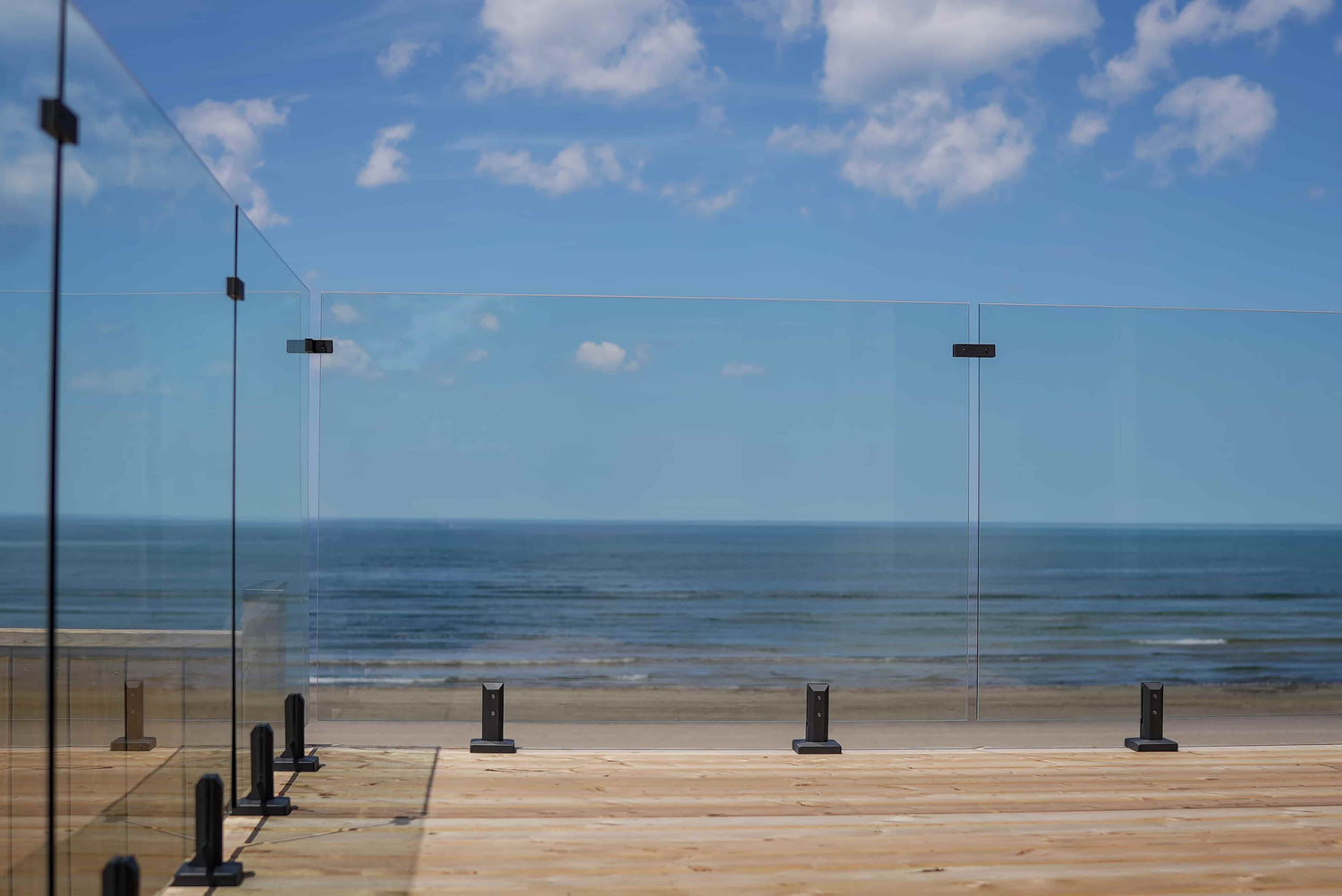Oregon Building Code for Glass Railings: Essential Rules for Safety and Design

Oregon is renowned for its wet climate, stunning scenery, and eco-friendly buildings. Glass railings enhance safety and aesthetic appeal whether you're designing a modern Portland home, a beachside getaway, or a picturesque deck in Bend. However, excellent design necessitates compliance. For good reason, glass railings are subject to stringent building codes in Oregon. It guarantees longevity, environmental compatibility, and public safety.
With the help of this tutorial, you may plan, build, or install glass railing systems in Oregon with complete confidence. Based on the most recent state-adopted residential and commercial norms, we will discuss glass options, height and spacing guidelines, safety glazing near damp areas, and structural strength.
Material and Load Requirements for Glass Railings
To meet Oregon code, the glass used in railings must be both visually clean and structurally sound. That means it must withstand pressure, weather exposure, and even seismic activity.
Laminated and Tempered Glass Requirements
With local modifications outlined in the Oregon Structural Specialty Code (OSSC) and Oregon Residential Specialty Code (ORSC), Oregon complies with the International Building Code (IBC) and International Residential Code (IRC). According to these codes, the glass used in guards must be either heat-strengthened laminated glass or laminated tempered glass. Making sure the glass doesn't break dangerously is the aim.
Glass Magazine states that each panel must have a safety factor of four and be able to withstand a 200-pound point load and a 50-pound-per-foot uniform load. In other words, your glass ought to be able to withstand 800 pounds of concentrated force without breaking.
If the guard includes glass balusters (vertical structural panels), Oregon requires additional top rails or edge protection unless the system passes ASTM post-breakage testing. Systems without top rails are generally not allowed unless they use multilayer laminated glass that continues to support load even after fracture. For a selection of glass types that meet these standards, visit glassrailingstore.com.

Guard Height and Infill Spacing Standards
Guardrails aren’t just about aesthetics. Their height and configuration prevent falls and create a safe environment on decks, balconies, and landings.
Minimum Heights
Oregon’s building code distinguishes between residential and commercial structures. For most homes and townhouses, IRC Section R312.1.2 sets the minimum guard height at 36 inches when there's a drop of 30 inches or more from the walking surface. For commercial buildings or apartments governed by the IBC, the requirement increases to 42 inches. Installing a guard that’s too short is a code violation. Always verify your building’s classification before choosing the height of your railing system.
Infill Spacing and the 4-Inch Rule
Regardless of the style or material, guards must be built so that a 4-inch sphere cannot pass through any opening. This includes gaps between glass panels, along the bottom, or around structural hardware. The purpose is to protect children and pets from slipping through or getting stuck.
See ICC’s 2018 IRC overview for residential guardrail regulations.
Safety Glazing in Hazardous Areas
Some areas of a home or commercial building require higher safety standards because of the risk of slips, falls, or human impact.
Glass Near Wet Zones, Stairs, and Landings
Oregon’s building code adopts IRC Section R308.4, which outlines where tempered safety glazing is mandatory. If your railing is located near a bathtub, shower, hot tub, pool, stairway, or ramp, and if any glass is within 60 inches horizontally and less than 60 inches vertically from the water's edge or stair nosing, it must be safely glazed. These locations are considered high-risk. Tempered glass is designed to break into small, blunt pieces rather than large, sharp shards, reducing injury risk. Laminated safety glass can also be used if it meets the same break resistance and post-breakage retention.
One common issue is assuming all glass is automatically safe for wet zones just because it's thick or decorative. The code is clear: it must be tested and labeled as safety glazing.
Seismic and Anchorage Considerations in Oregon
Oregon is in a seismically active zone, so railing systems must account for lateral forces that could shift or stress the structure during earthquakes.
Anchorage and Base Mounting Systems
All glass railing systems must be anchored securely to resist lateral loads, particularly in regions like Portland or along the Cascadia fault line. This means choosing base shoes, bolts, or spigots that have been tested to handle seismic activity. Check that your chosen hardware complies with ASTM E2358 and local interpretations of OSSC structural anchoring rules.
Additionally, Oregon OSHA requires fall protection measures that meet OAR 437-004-0320, including the secure installation of guardrails on any platform over 4 feet high. Whether you’re building a balcony on a sloped site or a high-rise terrace, make sure your installer understands these additional forces and selects mounting hardware accordingly. You can review Oregon OSHA’s anchoring guidance for guard systems.
Conclusion
Oregon's building code for glass railings reflects the state’s dedication to safety, design integrity, and adapting to regional risks. Whether you’re a contractor, homeowner, or designer, understanding the rules around guard height, infill spacing, safety glazing, and load capacity is critical.
Here are the core takeaways:
- Use laminated tempered or heat-strengthened glass tested to withstand 200 pounds of force.
- Follow height minimums: 36 inches for homes, 42 inches for commercial buildings.
- Ensure no opening allows a 4-inch sphere to pass through.
- Use safety glazing near water, stairs, and platforms.
- Anchor securely with seismic-resilient hardware.
By meeting these requirements, you ensure your railing isn’t just beautiful. It’s legally compliant and built to last.
Common Questions About Oregon Glass Railing Codes
1. Are glass railings legal in all parts of Oregon?
Yes. However, local offices may request additional documentation, especially in coastal or high-elevation zones.
2. Can I install my own railing as a homeowner?
Yes, but you must still follow the code and likely apply for a permit. Inspections will still be required.
3. How do I verify glass is code-compliant?
Look for permanent labeling indicating ANSI and CPSC compliance. Engineering reports are essential for laminated glass without a top rail.
4. Is the 36-inch rule always valid for homes?
Only if the platform is over 30 inches from the ground. Lower decks don’t require a guard.
5. How do I know if a product meets code?
Use tested, documented systems that provide performance data. This collection is a good place to start.
Let customers speak for us

Glass Railing Near You
Discover how The Glass Railing Store has been delivering exceptional service to our customers, thanks to our dedicated and knowledgeable team and their love our glass railing products.







